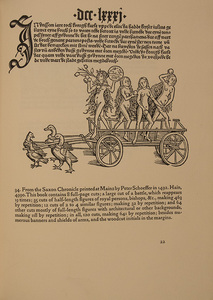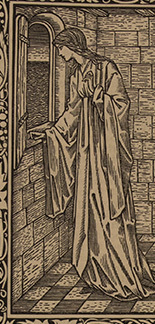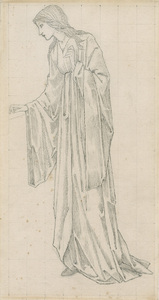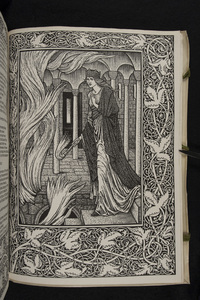Kelmscott Press
This publication by the Kelmscott Press after William Morris’s death includes a number of reproductions from books in William Morris’s library. An appendix includes a list of even more books in his library that were examples of 15th century German printing and woodcuts. This exhibit includes three leaves from the same editions as were in William Morris’s own library: Cronecken der Sassen, Legenda Aurea, and Rudimentum Novitiorum.
A striking example of the Arts and Crafts movement, The Works of Geoffrey Chaucer was the greatest achievement of William Morris’ Kelmscott Press. Here it is open to the Franklyn’s Tale scene with Aurelius and Dorigen. As with all of the Kelmscott publications, Morris designed the type based on medieval fonts. The intricate borders and design made of vines and leaves pay homage to the Arts and Crafts movement’s interests in medieval book arts and design.
A highly detailed pencil drawing of a girl in a dress is from illustrative materials for the Franklyn’s Tale. This drawing is an enlarged detail of the left-hand figure in the Aurelius and Dorigen woodcut illustration scene on page 167 of the Kelmscott The Works of Geoffrey Chaucer. Sir Edward Burne Jones drew the larger figure to scale in order to better show the draping folds of the dress.
This platinum print of a woodcut illustration of Aurelius and Dorigen depicts the scene from page 167 of the Kelmscott Press’s The Works of Geoffrey Chaucer. It is mounted on paperboard, more fully inked but unfinished, with ink and pencil detail studies in the margins.
Full-page illustration by Edward Burne-Jones, engraved by W. H. Hooper. This illustration depicts the character Gudrun holding a firebrand. Surrounding her image is a woodcut border of interwoven vines, leaves, and small dotted berries, which mirrors the intricate and lavish borders seen in medieval manuscripts. William Morris designed the border himself, one of the last he did for the Kelmscott Press.
Here is an example of the use of red and black ink, woodcut initial designs, and borders from the Kelmscott Press’ The Tale of Beowulf. William Morris’s love for Medieval English and Scandinavian myths drove him to translate Beowulf, the Old English heroic epic. Like the Kelmscott edition of Morris’s The Story of Sigurd the Volsung, The Tale of Beowulf’s designs and borders are comparatively similar to The Works of Geoffrey Chaucer.





![The tale of Beowulf : trial pages 23-[26] The tale of Beowulf : trial pages 23-[26]](http://omeka.wustl.edu/omeka/files/fullsize/ae37896e1cba8f5a427e12bd777fa16c.jpg)